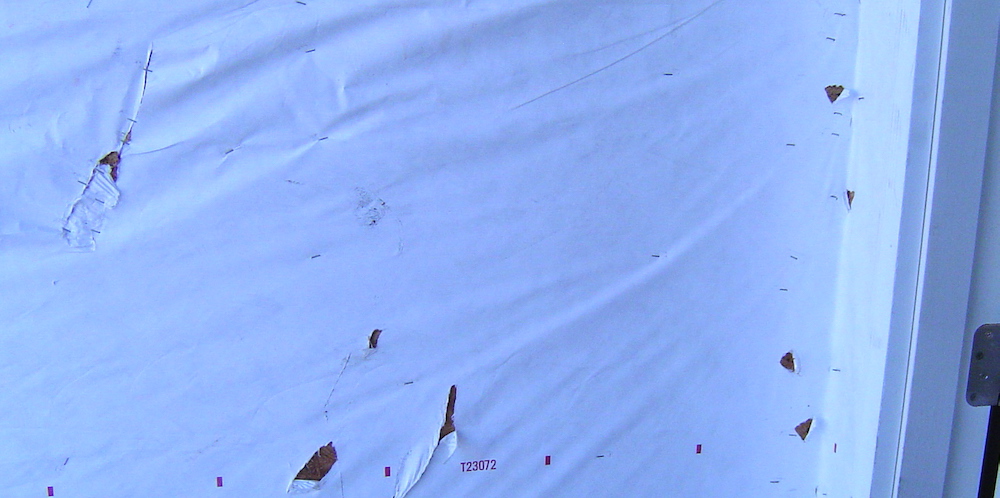5 Reasons House Wrap Is Not an Air Barrier

It took me a while to figure out that a building is basically just a structural framework with control layers. Yeah, there’s also electrical, plumbing, mechanical systems, and finishes, but the heart of a building is the stuff that holds it up and that moderates the flows of heat, air, and moisture between in and out.
One of those control layers is the air barrier. Of course, everyone knows now that a house can never be too tight (right?), so we want the air barrier to stop as much air flow across the building envelope as possible.
Many people believe that by putting house wrap on a building, you’ve got your air barrier taken care of. Although house wrap can qualify as an air barrier material, it usually doesn’t behave as an air barrier when installed. Here’s why:
- All seams must be sealed. Builders usually do a decent job here. After installing the layers of housewrap, they go back and tape the seams.
- Top and bottom edges must be sealed. This rarely happens.
- All the edges where it’s cut at rough openings must be sealed. Doesn’t happen.
- Cladding contractors cut it with their box cutters to get it to lie flat. When house wrap goes through an inside corner, it often ‘cuts the corner,’ making it impossible to install siding without slitting it.
- Innumerable tears, rips, and cuts allow air to move across it. They rarely get sealed before being covered with the cladding.
Because there are so many places that air can move across the house wrap, it doesn’t really perform as an air barrier when installed. There is one type of air leakage that it does help reduce, however – infiltration, air moving into the house (as opposed to exfiltration, air moving out of the house).
When the air pressure outside the house is higher than the pressure inside, air wants to move to the inside. This pulls house wrap into the seams, gaps, and penetrations and inhibits the flow of air from outside to inside (infiltration). If the house pressure is higher than the outside pressure, on the other hand, the house wrap pushes away from the holes and air moves out of the house (exfiltration).
So, if house wrap isn’t an air barrier, why do we use it?
House wrap’s best use is to act as the drainage plane on a building. This control layer keeps liquid water that gets behind the cladding from wetting the building materials. Tar paper (also called building paper or felt) is the traditional material used for this application, but house wrap has is the dominant choice these days. It’s kind of like Goretex for the house. It stops liquid water from going through, but it allows water vapor to pass so when the building materials do get wet, they can dry through the house wrap.
The more general term house wrap is weather resistive barrier (WRB), which implies that it’s there to keep the weather out. It does that for rain that gets behind the cladding, but it won’t resist air leakage due to wind, since wind puts a positive pressure on a house.
Bottom line: Don’t think of house wrap as an air barrier. It’s there to be the drainage plane.
Allison A. Bailes III, PhD is a speaker, writer, building science consultant, and the founder of Energy Vanguard in Decatur, Georgia. He has a doctorate in physics and writes the Energy Vanguard Blog. He also has a book on building science coming out in the fall of 2022. You can follow him on Twitter at @EnergyVanguard.
Comments are closed.
This Post Has 5 Comments
Comments are closed.

not to mention the thousands
not to mention the thousands of staples used in installation and the penetrations associated with securing the cladding
Gore-Tex for the house..
Gore-Tex for the house…great analogy!
I hired Joe L to help design
I hired Joe L to help design wall system for my previous home in Charlotte (1998). The cladding was hard-coat stucco and this was during the time when everyone was up in arms about building failures related to EIFS. Joe recommended 2 layers of 15# felt over the OSB sheathing (much less expensive than house wrap) and a layer of XPS over that. This put the vapor retarder in middle of thermal wall, appropriate for mixed humid climate. I used air-tight drywall approach to establish the air barrier layer. Although there are still some tricky details that must be addressed, there’s much less potential for getting mucked up by downstream work. The drywall sub couldn’t understand why I’d be willing to pay him a $1k premium to handle this detail, providing close supervision. The fact is, his upcharge plus the felt was less than what I would have spent on house wrap.
I hate it when builders /
I hate it when builders / trades refer to this product as sheathing for kneewalls . I will not allow it no matter what documentation they provide…..
It seams everone wants ther
It seams everone wants ther new house wraped now days–but I still like the idea of tar paper because when the sun gets the tar paper warm it turns the tar into a liqued & seals the area around the nail. TKS R/C